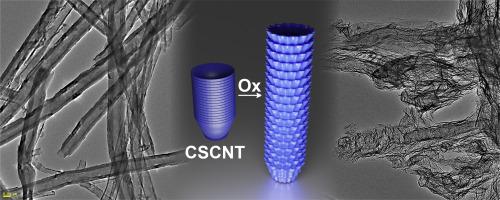面向介孔一维结构:扩展杯状堆叠碳纳米管的层间空间
IF 3.1
Q2 MATERIALS SCIENCE, MULTIDISCIPLINARY
引用次数: 0
摘要
调整材料的孔隙结构是实现高效离子/分子运输的关键。石墨材料中的层间空间可以通过氧化-剥落过程进行扩展。然而,由于插层氧化方法不适用于具有半封闭石墨结构的碳纳米管(CNTs),因此很少制备介孔一维纳米结构。本研究将基于改进Hummers方法的氧化应用于开边石墨结构的杯状堆叠碳纳米管(CSCNTs)。氧化程度由氧化剂与添加的CNTs的重量比控制。当氧化剂重量为cscnt重量的5倍时,可以实现基面完全氧化。热还原后CSCNTs的层间空间进一步扩大,形成了类似蜂窝形状的交错堆叠膨胀石墨烯层的介孔一维纳米结构,这表明CSCNTs独特的纳米结构对孔隙形成的重要性。对所得到的介孔一维结构进行热处理有助于提高结晶度,但随着热处理温度的升高,孔隙度特征也随之恶化。热致缺陷修复使石墨结构变平,也引起了层叠;因此,这揭示了结晶度和孔隙度之间的权衡关系。本文章由计算机程序翻译,如有差异,请以英文原文为准。

Toward mesoporous 1D structures: Expanding interlayer spaces in cup-stacked Carbon nanotubes
Tailoring the pore structure in materials is a key to achieving efficient ion/molecular transportation. The interlayer space in graphitic materials can be expanded via the oxidation–exfoliation process. However, since the intercalation-mediated oxidation method does not work for carbon nanotubes (CNTs) that have semi-closed graphitic structures, mesoporous 1D nanostructure has been rarely prepared. In the present study, modified Hummers method-based oxidation was applied to cup-stacked carbon nanotubes (CSCNTs) with open-edge graphitic structure. The degree of oxidation was controlled by the weight ratio of the oxidant and added CNTs. The complete basal-plane oxidation was achieved when the oxidant was 5 times the weight of CSCNTs. Following thermal reduction further expanded the interlayer spaces of the CSCNTs resulting in the formation of mesoporous 1D nanostructure with alternating stacked–expanded graphene layers resembling honeycomb shape, indicating the importance of the unique nanostructure of CSCNTs for pore formation. Heat-treatment of the obtained mesoporous 1D structure helped improve the crystallinity, but at the same time deteriorated the porosity features as the heat-treatment temperature increased. Thermally induced defect repairing flattened the graphitic structure which also induced layer restacking; thus, this revealed the trade-off relationship between the crystallinity and porosity.
求助全文
通过发布文献求助,成功后即可免费获取论文全文。
去求助
来源期刊

Carbon Trends
Materials Science-Materials Science (miscellaneous)
CiteScore
4.60
自引率
0.00%
发文量
88
审稿时长
77 days
 求助内容:
求助内容: 应助结果提醒方式:
应助结果提醒方式:


